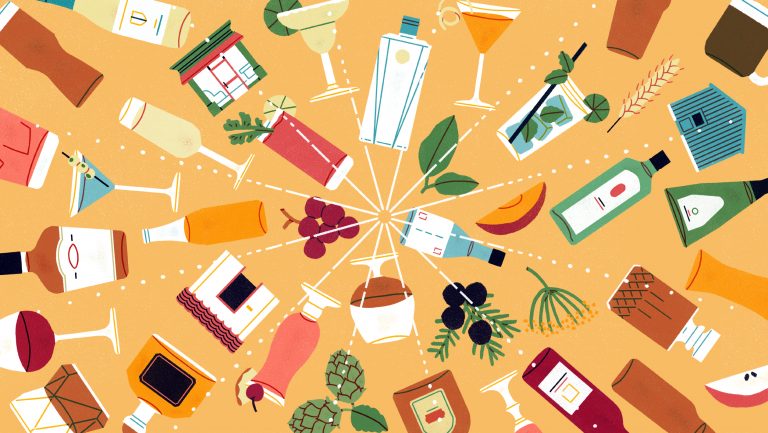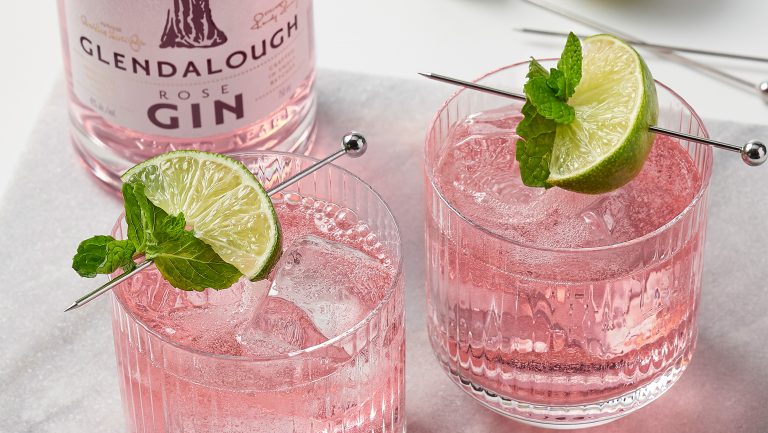From philosophies of “rosé all day” to panic over rosé shortages, it’s safe to say that the color pink has become a fixture in the wine industry. According to IWSR Drinks Market Analysis, rosé wine sales volume grew by 118 percent from 2015 to 2020, and it’s expected to increase by almost 70 percent from 2020 to 2024.
But now—combined with the rise of flavored vodkas in the early aughts, a gin renaissance throughout Europe, and the Instagram-fueled drive to capture and share beautiful cocktail images—the “drink pink” trend has spilled over to the spirits industry.
Over the past five years, distillers have begun to imbue otherwise clear spirits with rosy hues. Peruse back bars from Miami to Los Angeles and Barcelona to Dublin, and there’s likely to be pink-colored spirits interspersed among the clear vodkas and gins.

Don’t miss the latest drinks industry news and insights. Sign up for our award-winning Daily Dispatch newsletter—delivered to your inbox every week.
In July, IWSR Drinks Market Analysis projected that pink tequila would grow at a volume compound annual growth rate (CAGR) of seven percent from 2021 to 2026 after already experiencing 17 percent growth in 2021. The same report revealed a similar success for pink gin, which grew 16 percent in volume in 2021 and a whopping 263.6 percent CAGR between 2015 and 2019.
Despite these impressive numbers, some beverage professionals remain skeptical of the pink spirits category and its ability to drive long-term sales. Is this color trend just a fad—or are pink spirits legitimate inventory assets?
Gin’s Rosy Spark
It was the gin category that really kicked off the pink spirits trend. In 2017, Gordon’s released a pink gin, followed by Malfy Rosa, Beefeater Pink Strawberry Gin, and others in 2018. In that same year, when Pá Burke helped open Hyde Bar as head mixologist in Galway, Ireland, he remembers opening with more than 600 gins on the menu, the most of any bar in Ireland at the time—and pink was making its way into the mix.
“A lot of what we saw at first were gins with sweet, artificial flavors like strawberry or other berries,” says Burke. “They weren’t exactly your gin lover’s kind of gin. But in a way, they got people interested in gin. They’re sort of a gateway that you can mix with lemon and sodas for a sweeter, summery cocktail.”
Over the years, Burke noticed a growth in premium pink gins with added complexity from aging in red wine barrels, or infusing with pink florals and botanicals. The trend became so intriguing that the bar partnered with a local Irish producer, Clonakilty Distillery, to develop a small-batch, proprietary gin aged in Bordeaux barrels.

“It was a way to expand the customer experience of pink gin in a way that we enjoy,” says Burke, who recommends simpler preparations for the blush-hued Hyde Bar gin, such as in a chilled Martini or with a cube of ice.
When Glendalough Distillery set out to release a pink gin in 2018, head distiller Ciarán Rooney intended for it to be a tribute to his mother, Rose. Pink rose petals from her garden, as well as a blend of botanicals foraged from the nearby Wicklow mountains south of Dublin, added a distinct, natural rosy hue and subtle floral characteristics.
Though whiskey comprises about 60 percent of the distillery’s overall production, the popularity of the pink gin—dubbed Rose Gin—has garnered a healthy amount of the facility’s attention, particularly given its popularity in the U.S.
“We launched Rose Gin in the States in 2019 as part of our core range offering. The trends for flavored gins at the time supported a decision to launch it in markets worldwide,” says brand manager Seán Windsor, adding that there has been a 31 percent increase in sales since that time.
Maturing Pink Spirits Production
Many spirits producers rely on berry-flavored color additives or flowers and botanicals to add color to their clear spirits, but tequila producers have quickly adopted red wine barrel finishing to create their pink iterations—a process that adds depth and complexity to blanco tequila bases.
This wasn’t necessarily the case early on, says Alfredo Sanchez, the general manager of Evelyn’s at the Four Seasons in Fort Lauderdale, Florida. “It was very disappointing,” he says of his first experience with pink tequila a few years ago in Mexico City. “The tequila was very artificial-looking, very unnaturally pink. At that time, the tequila brand’s strategy was to attract the female demographic, rather than focusing on quality.”
But other brands quickly changed tack; a year later, Sanchez tasted Gran Centenario Rosangel. “It had been aged in port barrels and then infused with hibiscus flowers. It was a very interesting product for bartenders to play around with, making cocktails such as hibiscus margaritas with a nice pink finish,” says Sanchez. “Now that the trend has matured, most rosé tequilas are blancos finished in a barrel of some sort.”

Developing a premium spirit to compliment the natural agave flavors of a blanco tequila was the goal Código 1530 cofounder Federico “Fede” Vaughan had when bringing the Rosa Blanco into the portfolio in 2016.
But Vaughan was careful not to tread into the pink territory too quickly. “I’ve seen too many reactions to some of these products where people say ‘that’s not natural,’” says Vaughan. “To me, I wasn’t interested in achieving a color. I was interested in a natural process.”
In fact, Código’s pink tequila inspiration resulted from an established process for the brand’s reposado and añejo tequilas, which are both aged in red wine barrels. In order to take advantage of this wine-stained oak, Vaughan forewent the charring process and rested another tequila in these barrels first.
“It seemed like such a waste to not do something with the tequila that came off these barrels, so we decided to try aging our blanco for just a short time to see what would happen,” he says. The result was a beautiful blush color that didn’t mar the flavor of the tequila. “It had this fantastic aroma, which was really important to me because I think blanco is the purest form of tequila.”
According to Vaughan, since its initial release, the Rosa experienced growth of more than 60 percent each year—well above the company’s annual projections.
A Cross-Section of Consumers
Though the color pink is often stereotyped as a “feminine” hue, Burke has noticed a balanced demand for pink gin from both men and women.
“People just want something fun to drink,” says Burke. “The gin and tonic craze in Spain with big-bowl glasses filled with fruit, flowers, and spices helped that perception. Having a pink gin and tonic or something similarly refreshing just fits.”
Vodka producer New Amsterdam gambled on the appeal of pink spirits across demographics when introducing Pink Whitney in 2019. The pink lemonade-flavored vodka was inspired by Ryan Whitney, a NHL player and the co-host of the Spittin’ Chiclets podcast.
“I wish I could say there was a grand plan or strategy, but the truth is it all started when Ryan Whitney was asked how he liked to drink New Amsterdam and he said ‘with pink lemonade,’” says Britt West, the senior vice president and general manager for Spirit of Gallo, which owns New Amsterdam. “All we did from there was develop a product that matched—and met consumer demand.”

Though the initial demographic began with hockey fans, West shared that the predominant audience today is among 25 to 35-year-old men and women from all over the U.S. and Canada.
The pink gin craze helped pave the way for Pink Whitney’s success, as did the establishment of pink vodkas from brands such as Hangar 1 and Three Olives in 2018. But West attributes much of the ease in releasing Pink Whitney successfully to the power of social media. It’s an assertion that was backed up by a 2018 report that color would continue to “be a key trend in 2018, with social media being a key driver.”
“These days, rosé spirits are in high demand,” says Sanchez. “The color pink relates to fun and feeling good, and many bartenders are playing with the color more and more.”
Sanchez first incorporated the Código 1530 Rosa Blanco into his bar program as part of an educational tequila tasting in 2019, when he worked at Santa Fe’s Four Seasons Rancho Encantado. Now at Evelyn’s, he uses it as part of a premium spirits selection as a sipping tequila, as well as in some cocktails such as Ranch Waters and tequila Manhattans.
At Toca Madera in Scottsdale, Arizona, bar manager Michael Nester has incorporated pink tequila into Paloma cocktails and original concoctions such as the Como la Flor, a light, refreshing blend of the Código 1530 Rosa Blanco, guava, lemon juice, and rose water. Still, he prefers to serve it on its own with just a little ice.
“The Rosa Blanco has become one of my favorite tequilas not only to play with as a bartender, but also to enjoy personally at home,” says Nester. “I love the unique flavor the wine barrels give; it’s like no other tequila.”
Whether beverage professionals see pink spirits as a social media-fueled gimmick or a legitimate addition to a bar program, this rosy-hued category is certainly driving sales. With its proven appeal, who’s to say that producers will stop at pink, either?
“I think that in terms of color, pink is just the beginning, and we’ll continue to see a trend of colorful spirits in the future,” says Sanchez.

Dispatch
Sign up for our award-winning newsletter
Don’t miss the latest drinks industry news and insights—delivered to your inbox every week.
Jessica Dupuy is a wine, spirits, and food writer based in Austin, Texas, whose credits include work in Texas Monthly, Imbibe magazine, Wine Enthusiast magazine, Sommelier Journal, and The Tasting Panel magazine and with the Guild of Sommeliers. A Certified Sommelier, Certified Specialist of Wine, and Certified Specialist of Spirits, she holds the Diploma in Wines through the Wine & Spirits Education Trust. Dupuy keeps her palate sharp through travel, reading, and endless tasting.


